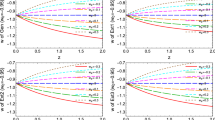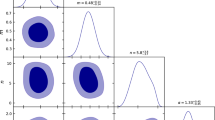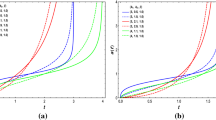Abstract
We investigate a second order parabolic parametrization, w(a) = w t + w a (a t − a)2, which is a direct characterization of a possible turning in w. The cosmological consequence of this parametrization is explored by using the observational data of the SNLS3 type Ia supernovae sample, the CMB measurements from WMAP9 and Planck, the Hubble parameter measurement from HST, and the baryon acoustic oscillation (BAO) measurements from 6dFGS, BOSS DR11 and improved WiggleZ. We found the existence of a turning point in w at a ∼ 0.7 is favored at 1σ CL. In the epoch 0.55 < a < 0.9, w < −1 is favored at 1σ CL, and this significance increases near a = 0.8, reaching a 2σ CL. The parabolic parametrization achieve equivalent performance to the ΛCDM and Chevallier-Polarski-Linder (CPL) models when the Akaike information criterion was used to assess them. Our analysis shows the value of considering high order parametrizations when studying the cosmological constraints on w.
Similar content being viewed by others
References
Riess A G, Filippenko A V, Challis P, et al. Observational evidence from suprenovae for an accelerating universe and a cosmological constant. Astron J, 1998, 116: 1009–1038
Perlmutter S, Aldering G, Goldhaber G, et al. Measurements of Ω and Λ from 42 high-redshift supernovae. Astrophys J, 1999, 517: 565–586
Sahni V, Starobinsky A. The case for a positive cosmological lambdaterm. Int J Mod Phys D, 2000, 9: 373–444
Peebles P J E, Ratra B. The cosmological constant and dark energy. Rev Mod Phys, 2003, 75: 559
Frieman J, Turner M, Huterer D. Dark energy and the accelerating universe. Annu Rev Astron Astrophys, 2008, 46: 385–432
Li M, Li X D, Wang S, et al. Dark Energy. Commun Theor Phys, 2011, 56: 525–604
Peebles P J E, Yu J T. Primeval adiabatic perturbation in an expanding universe. Astrophys J, 1970, 162: 815–836
Eisenstein D J, Hu W. Baryonic features in the matter transfer function. Astrophys J, 1998, 496: 605–614
Anderson L, Aubourg E, Bailey S, et al. The clustering of galaxies in the SDSS-III Baryon Oscillation Spectroscopic Survey: Baryon acoustic oscillations in the data release 10 and 11 galaxy samples. arXiv:1312.4877
Kazin E A, Koda J, Blake C, et al. Improved WiggleZ dark energy survey distance measurements to z = 1 with reconstruction of the baryonic acoustic feature. arXiv:1401.0358
Eisenstein D J, Seo H J, Sirko E, et al. Improving cosmological distance measurements by reconstruction of the baryon acoustic peak. Astrophys J, 2007, 664: 675–679
Chevallier M, Polarski D. Accelerating universes with scaling dark matter. Int J Mod Phys D, 2001, 10: 213–224
Linder E V. Exploring the expansion history of the universe. Phys Rev Lett, 2003, 90: 091301
Barreiro T, Copeland E J, Nunes N J. Quintessence arising from exponential potentials. Phys Rev D, 2000, 61: 127301
Hu W, Sawicki I. Models of f (R) cosmic acceleration that evade solar system tests. Phys Rev D, 2007, 76: 064004
Starobinsky A A. Disappearing cosmological constant in f (R) gravity. JETP Lett, 2007, 86: 157–163
Appleby S A, Battye R A. Do consistent F(R) models mimic general relativity plus Λ? Phys Lett B, 2007, 654: 7–12
Baldi M. Early massive clusters and the bouncing coupled dark energy. Mon Not R Astron Soc, 2012, 420: 430–440
Li M, Ma Y Z, Zhang X, et al. Planck constraints on holographic dark energy. J Cosmol Astropart Phys, 2013, 09: 021
Alam U, Sahni V, Saini T D, et al. Is there supernova evidence for dark energy metamorphosis? Mon Not R Astron Soc, 2004, 354: 275–291
Zhao G B, Crittenden R G, Pogosian L, et al. Examining the evidence for dynamical dark energy. Phys Rev Lett, 2012, 109: 171301
Holsclaw T, Alam U, Sansó B, et al. Nonparametric dark energy reconstruction from supernova data. Phys Rev Lett, 2010, 105: 241302
Shafieloo A, Kim A G, Linder E V. Gaussian process cosmography. Phys Rev D, 2012, 85: 123530
Seikel M, Clarkson C, Smith M. Reconstruction of dark energy and expansion dynamics using Gaussian processes. J Cosmol Astropart Phys, 2012, 1206: 036
Crittenden R G, Zhao G B, Pogosian L, et al. Fables of reconstruction: Controlling bias in the dark energy equation of state. J Cosmol Astropart Phys, 1202, 2012: 048
Wang F Y, Dai Z G. Estimating the uncorrelated dark energy evolution in the Planck era. Phys Rev D, 2014, 89: 023004
Linder E V, Huterer D. How many dark energy parameters? Phys Rev D, 2005, 72: 043509
Sarkar D, Sullivan S, Joudaki S, et al. Beyond two dark energy parameters. Phys Rev Lett, 2008, 100: 241302
Komatsu E, Smith K M, Dunkley J, et al. Seven-year Wilkinson Microwave Anisotropy Probe (WMAP) observations: Cosmological interpretation. Astrophys J Suppl, 2011, 192: 18–64
Guy J, Sullivan M, Conley A, et al. The Supernova Legacy Survey 3-year sample: Type Ia supernovae photometric distances and cosmological constraints. Astron Astrophys, 2010, 523: A7
Sullivan M, Guy J, Conley A, et al. SNLS3: Constraints on dark energy combining the supernova legacy survey three-year data with other probes. Astrophys J, 2011, 737: 102
Conley A, Sullivan M, Hsiao E Y, et al. SiFTO: An empirical method for fitting SN Ia light curves. Astrophys J, 2008, 681: 482–498
Guy J, Astier P, Baumont S, et al. SALT2: Using distant supernovae to improve the use of type Ia supernovae as distance indicators. Astron Astrophys, 2007, 466: 11–21
Zhang Z H, Li M, Li X D, et al. Generalized holographic dark energy and its observational constraints. Mod Phys Lett A, 2012, 27: 1250115
Hinshaw G, Larson D, Komatsu E, et al. Nine-year Wilkinson Microwave Anisotropy Probe (WMAP) observations: Cosmological parameter results. Astrophys J Suppl, 2013, 208: 19
Ade P A R, Aghanim N, Armitage-Caplan C, et al. Planck 2013 results. I. Overview of products and scientific results. arXiv:1303.5062
Ade P A R, Aghanim N, Armitage-Caplan C, et al. Planck 2013 results. XVI. Cosmological parameters. arXiv:1303.5076
Wang Y, Wang S. Distance priors from Planck and dark energy constraints from current data. Phys Rev D, 2013, 88: 043522
Hu W, Sugiyama N. Small-scale cosmological perturbations: An analytic approach. Astrophys J, 1996, 471: 542–570
Beutler F, Blake C, Colless M, et al. The 6dF galaxy survey: Baryon acoustic oscillations and the local Hubble constant. Mon Not R Astron Soc, 2011, 416: 3017–3032
Eisenstein D J, Zehavi I, Hogg D W, et al. Detection of the baryon acoustic peak in the large-scale correlation function of SDSS luminous red galaxies. Astrophys J, 2005, 633: 560–574
Addison G E, Hinshaw G, Halpern M. Cosmological constraints from baryon acoustic oscillations and clustering of large-scale structure. Mon Not R Astron Soc, 2013, 436: 1674–1683
Padmanabhan N, Xu X Y, Eisenstein D J, et al. A 2% distance to z = 0.35 by reconstructing baryon acoustic oscillations—I: Methods and application to the Sloan Digital Sky Survey. Mon Not R Astron Soc, 2012, 427: 2132–2145
Riess A G, Macri L, Casertano S, et al. A 3% solution: Determination of the Hubble constant with the Hubble space telescope and wide field camera 3. Astrophys J, 2011, 730: 119
Lewis A, Bridle S. Cosmological parameters from CMB and other data: A Monte Carlo approach. Phys Rev D, 2002, 66: 103511
Felice A D, Nesseris S, Tsujikawa S. Observational constraints on dark energy with a fast varying equation of state. J Cosmol Astropart Phys, 2012, 1205: 029
Author information
Authors and Affiliations
Corresponding author
Additional information
Contributed by LI Miao (Associate Editor)
Rights and permissions
About this article
Cite this article
Hu, Y., Li, M., Li, X. et al. Investigating the possibility of a turning point in the dark energy equation of state. Sci. China Phys. Mech. Astron. 57, 1607–1612 (2014). https://doi.org/10.1007/s11433-014-5497-y
Received:
Accepted:
Published:
Issue Date:
DOI: https://doi.org/10.1007/s11433-014-5497-y




